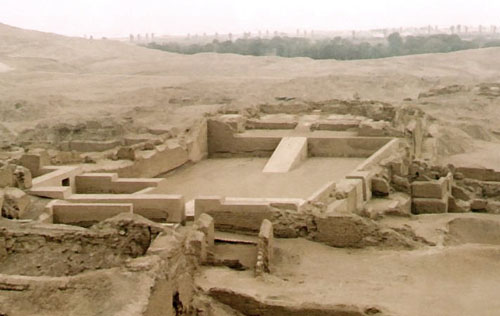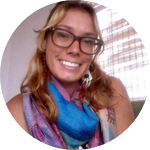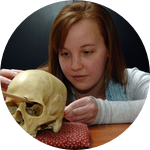About This Project
The Peruvian Central Coast has not been extensively explored through archaeological research. This project aims to determine mortuary practices at Panquilma (c. AD 900-1532), a secondary site to the most important religious center of the South American coast, Pachacamac, and how they reflect the social and political organization of the Ychsma people that lived 600 years ago prior to the arrival of the Inca in this region.
Ask the Scientists
Join The DiscussionWhat is the context of this research?
This project has been ongoing for the past 3 summers but the mortuary archaeology portion only started a year and a half ago. This 2015 field season will focus on human skeletal remains recovered from Panquilma (c. AD 900-1532) just south of Lima. Panquilma was a secondary Ychsma community to the most important religious center of the South American coast, Pachacamac.
Although extensive studies have occurred at Pachacamac, the secondary Ychsma sites have rarely been archaeologically explored. It is especially important to address the nature of the rural elites that lived at the secondary sites [such as Panquilma] and the influence that the religious center [Pachacamac] had in the development of their power strategies.
What is the significance of this project?
Because a majority of the work regarding the Ychsma culture has been conducted at Pachacamac, our knowledge and understanding of this culture are skewed. Thus, research is necessary at the secondary Ychsma sites in order to understand the minute details that made up the culture that once worshipped the deity of Ychsma/Pachacamac. Conducting a mortuary study of secondary sites may redress this gap in our knowledge of Ychsma social structure.
This summer we will be gathering evidence from the cemetery and houses in order to evaluate the mortuary practices employed and what we can infer about the living from the dead. This will help us better understand the community the ruled the Peruvian Central Coast for so long and allow for others to build on and further explore this region.
What are the goals of the project?
This funding will be used to support this foundation's three month field season of excavation and analysis at the site of Panquilma. Our project goals for this summer include:
- To involve the local communities (teachers, school children and community members) in our archaeological process and aim to inspire future local archaeologists.
- To excavate 2 above-ground funerary chambers in the Panquilma cemetery.
- To survey 2 additional Ychsma sites and their layouts.
- To conduct 2 in-ground test units of potential funerary processing structures that border the cemetery.
- To analyze all of the material remains that come back to the laboratory.
Budget
This funding will supply two young students, a Master's and PhD student, as well as field school students with the opportunity to not only collect data for research but to also create a foundation for long-term, archaeological research on the Central Coast of Peru. Although we have applied for numerous grants, funding for archaeological projects is extremely limited and highly competitive. This research cannot happen without your help.
The first $5000 project funding goal will go towards the budget listed and anything over that will go towards in-country support for hiring more local workers and getting more children involved in their local community while inspiring them to prevent future looting and potentially become archaeologists themselves.
Endorsed by
Meet the Team
Team Bio
Alysia Leon
I was always fascinated by fossils as a child and would have to be forced to come inside at dusk. These passions never transpired into anything until relatively recently. I began my undergraduate career majoring in Deaf Education but quickly realized that it was not the field I was meant to be in. I was convinced by a friend to take a Cultural Anthropology course and I immediately fell in love. archaeological field school in the United States' oldest city, Saint Augustine, Florida. While in undergrad, I participated in field schools in Costa Rica and Peru. I began to teach myself about Osteology and Mortuary Archaeology upon unearthing my first set of human remains and ever since I have been continuing this journey.
Megan Cleary
Since I first visited Mesa Verde on a family vacation, I've been interested in past societies. When I took my first anthropology class my freshman year of college, I was fascinated. Every facet of biological anthropology intrigued me, from our primate relatives to modern human variation. After undergrad, I began graduate school at Southern Illinois University. At SIU I was able to focus on bioarchaeology and forensic anthropology.
Alysia and Megan will both be working at Panquilma this summer to complete research towards a Master's and Ph.D. degrees. Alysia will focus on Mortuary Archaeology for her Master's thesis while Megan will focus on Bioarchaeology for her Ph.D. dissertation.
Alysia Leon
I was always fascinated by fossils as a child and would have to be forced to come inside at dusk. These passions never transpired into anything until relatively recently. I began my undergraduate career majoring in Deaf Education but quickly realized that it was not the field I was meant to be in. I was convinced by a friend to take a Cultural Anthropology course and I immediately fell in love. That summer I signed up for an archaeological field school in the United States' oldest city, Saint Augustine, Florida. While in undergrad, I participated in field schools in Costa Rica and Peru. Of course I fell in love with the preservation in the dry desert of Peru. I began to teach myself about Osteology and Mortuary Archaeology upon unearthing my first set of human remains and ever since I have been continuing this journey.
I am now currently attending the Southern Illinois University of Carbondale to obtain my Master's degree under the advisement of Dr. Izumi Shimada. I am focusing on understanding the everyday lives of the Ychsma civilization of the Peruvian Central Coast through mortuary archaeological analysis.
Megan Cleary
Since I first visited Mesa Verde on a family vacation, I've been interested in past societies. When I took my first anthropology class my freshman year of college, I was fascinated. Every facet of biological anthropology intrigued me, from our primate relatives to modern human variation. After undergrad, I began graduate school at Southern Illinois University. At SIU I was able to focus on bioarchaeology and forensic anthropology.
For my dissertation project I am exploring health at the Pre-Incan site of Panquilma outside of modern day Lima in Peru. To look at health, I will be examining the skeletal remains that have been excavated in past field seasons, as well as the remains I will help excavate this summer. Many of these remains are commingled, which makes them more difficult to examine than individual burials. In addition to exploring overall health of the population, I will be exploring different methodologies for analyzing commingled remains.
Additional Information

The site of Panquilma (above and below)


Mortuary Archaeological Analysis from 2013 Field Season

The most important religious site of the Andean Central Coast, Pachacamac.

This is an example of a looted cemetery cist that we will be exploring further.

Mapping a burial in 2013.

A rendition of the Beatles Abbey Road with pre-Columbian ceramics.

Laboratory work, cleaning 600 year old botanical remains!
Project Backers
- 7Backers
- 6%Funded
- $253Total Donations
- $36.14Average Donation


